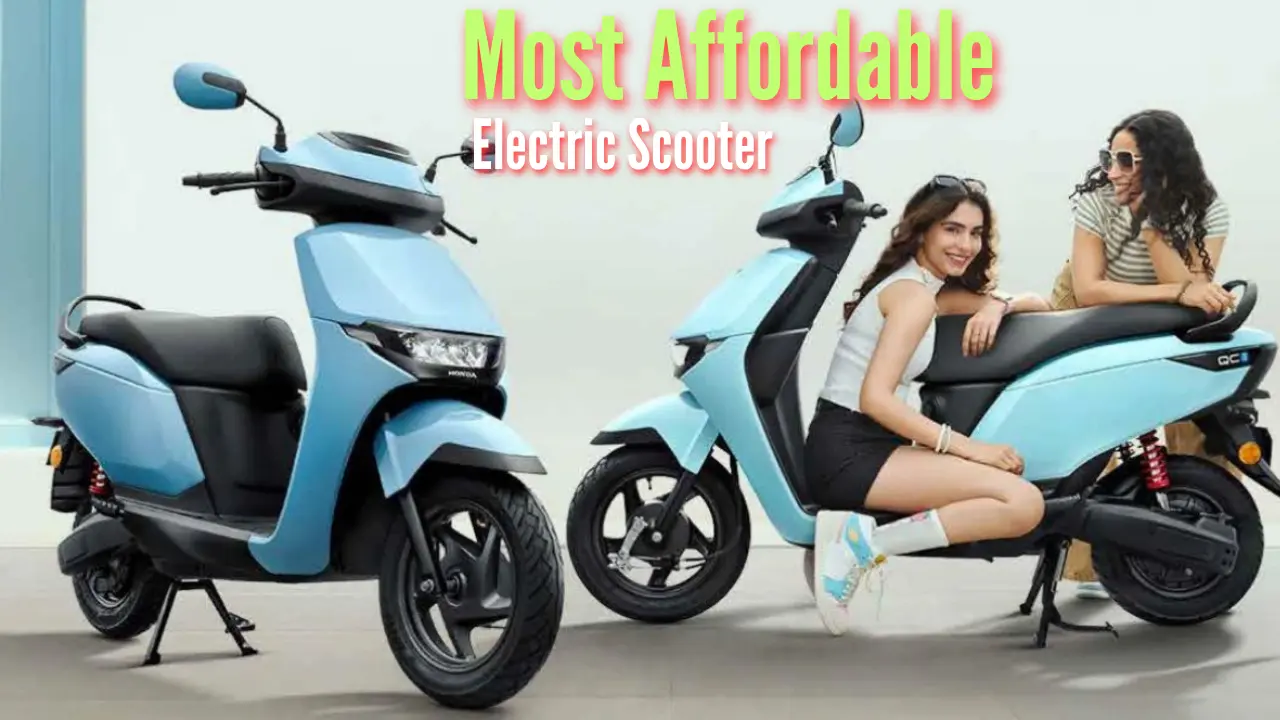Honda QC1 Electric Scooter: Honda has just pulled the wraps off its most affordable electric scooter in India — the QC1 — and it’s priced pretty aggressively too. With an ex-showroom tag starting at Rs 90,000, the QC1 offers a no-frills entry into Honda’s EV lineup, aimed squarely at budget-conscious city riders.
The QC1 isn’t trying to dazzle with futuristic gimmicks — and that might be its biggest strength. As Honda makes a serious move into India’s booming electric scooter space (which now makes up 7% of total scooter sales), the QC1 delivers what most buyers actually want: practicality, reliability, and a familiar feel.
This one’s clearly designed for the urban grind — school runs, quick grocery dashes, or short office commutes. If you’re someone who’s been eyeing an EV but didn’t want to take a risk on a new brand, this could be the comfortable first step.
Understated Design That Grows on You
Think of the QC1 as the electric sibling of the Honda Activa — clean, sensible, and instantly familiar. It won’t turn heads at a traffic light, but it won’t look outdated in five years either. The bodywork is simple and uncluttered, with a touch of modernity thanks to the all-LED lighting setup.
A wide seat, flat floorboard, and a light 89.5kg kerb weight make it super manageable — especially for new riders or those navigating crowded streets. As expected from Honda, the scooter feels solidly put together even if it doesn’t scream “premium.”
And yes, there’s some colour choice too: Pearl Shallow Blue, Pearl Serenity Blue, Pearl Misty White, Pearl Nightstar Black, and Matte Foggy Silver Metallic — enough variety for most people.
Read Also: TVS Raider 125 vs Honda SP 125: Which 125cc Bike Wins?
Performance: Great for the City, But Don’t Expect Thrills
Under the skin, the QC1 gets a 1.5kWh fixed battery paired with a 1.8kW BLDC motor pushing out a healthy 77Nm of torque. Honda says it’ll go 80km on a full charge, though you can expect closer to 70km in real-world riding depending on how you ride and what traffic looks like.
Top speed? Just 50kmph — and that’s where things start to feel limiting. It’s fine for city roads, but anything faster (like a ring road or highway stretch), and you’ll find yourself getting overtaken by autorickshaws. The Eco mode drops that speed to just 30kmph — which feels downright dangerous in urban traffic and is best avoided.
Throttle response isn’t the most refined either. Standard mode gives you usable performance, but the throttle feels either fully on or off — not ideal when you’re trying to ease through stop-and-go traffic. Expect a bit of wrist strain on longer rides.
Features: Just Enough, and That’s Okay
Don’t expect fancy screens or connected tech. The QC1 keeps it basic — and that’s refreshing. You get a 5-inch LCD display showing all the key info, a USB Type-C charging port (handy for your phone), and 26 litres of underseat storage — roomy enough for a half-face helmet and a few groceries.
Charging takes about 4.5 hours using the included 330W off-board charger — just plug it in overnight and you’re good to go the next day.
As for riding modes, there are two: Eco and Standard. But like we mentioned earlier, Eco mode’s too slow to be practical.
Honda QC1 City-Wise On-Road Prices
| City | On-Road Price |
|---|---|
| New Delhi | Rs 93,870 |
| Mumbai | Rs 94,094 |
| Bengaluru | Rs 1,06,000 |
| Kolkata | Rs 96,530 |
| Pune | Rs 94,094 |
| Hyderabad | Rs 94,094 |
Prices vary depending on local taxes and EV subsidies. Bengaluru’s higher pricing, for instance, reflects a steeper state tax compared to cities like Mumbai or Pune that offer better incentives.
Living With the QC1
Spend a few days with the QC1 and you’ll get a clear picture: it’s built for short-range city life. It’s perfect for daily errands, short commutes, and school drops within a 30–40km radius. It rides like a typical Honda — comfortable seating, intuitive ergonomics, and no surprises.
But the 50kmph speed cap can be frustrating. You’ll have to rethink routes to avoid faster roads, which isn’t ideal if your daily ride includes highways or express stretches.
Also, since the battery is fixed, there’s no pulling it out to charge inside your apartment. You’ll need parking with a power outlet nearby — a consideration for anyone living in flats without ground-floor charging options.
The Competition: Does the QC1 Hold Up?
At Rs 90,000 ex-showroom, the QC1 squares off against the Ola S1 Air and Bajaj Chetak. The Ola gives you snazzier features and slightly more performance. The Chetak, on the other hand, feels more upmarket.
What the QC1 brings to the table is Honda’s bulletproof after-sales network and peace-of-mind ownership — two things that still matter more than fancy dashboards for most Indian buyers.
Insurance costs fall between Rs 6,000–8,000 annually, with EMI plans starting at roughly Rs 1,733/month for a 5-year loan at 8.5% interest.
Final Thoughts: Should You Buy One?
Let’s be real — the QC1 isn’t going to set your pulse racing. But maybe it doesn’t need to. It’s meant to be a reliable, low-maintenance, everyday electric scooter for people who just want something that works.
Yes, that 50kmph top speed is a compromise you’ll have to live with. If your commute involves quick-moving roads, this isn’t the scooter for you. But for purely urban usage where speeds rarely exceed 40-45kmph, the QC1 nails its brief.
It’s simple, no-nonsense, and unmistakably Honda. And for many Indian families, that’s more than enough.
